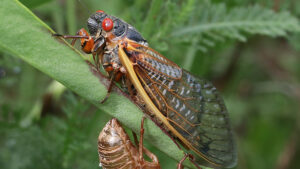Cicadas, Katydids, & Crickets
go.ncsu.edu/readext?1001077
en Español / em Português
El inglés es el idioma de control de esta página. En la medida en que haya algún conflicto entre la traducción al inglés y la traducción, el inglés prevalece.
Al hacer clic en el enlace de traducción se activa un servicio de traducción gratuito para convertir la página al español. Al igual que con cualquier traducción por Internet, la conversión no es sensible al contexto y puede que no traduzca el texto en su significado original. NC State Extension no garantiza la exactitud del texto traducido. Por favor, tenga en cuenta que algunas aplicaciones y/o servicios pueden no funcionar como se espera cuando se traducen.
Português
Inglês é o idioma de controle desta página. Na medida que haja algum conflito entre o texto original em Inglês e a tradução, o Inglês prevalece.
Ao clicar no link de tradução, um serviço gratuito de tradução será ativado para converter a página para o Português. Como em qualquer tradução pela internet, a conversão não é sensivel ao contexto e pode não ocorrer a tradução para o significado orginal. O serviço de Extensão da Carolina do Norte (NC State Extension) não garante a exatidão do texto traduzido. Por favor, observe que algumas funções ou serviços podem não funcionar como esperado após a tradução.
English
English is the controlling language of this page. To the extent there is any conflict between the English text and the translation, English controls.
Clicking on the translation link activates a free translation service to convert the page to Spanish. As with any Internet translation, the conversion is not context-sensitive and may not translate the text to its original meaning. NC State Extension does not guarantee the accuracy of the translated text. Please note that some applications and/or services may not function as expected when translated.
Collapse ▲One of the telltale signs of the impending arrival of summer are the sounds of insect mating calls that can sometimes be deafening on certain evenings. These insects are cicadas, katydids, and crickets. Cicadas are large insects related to aphids and other insects that feed on plants with sucking mouthparts. There are many species of cicadas that appear each year during the summer. These are called annual or dog day cicadas and have a different life cycle then the periodical cicadas that emerge every 13 or 17 years. This year is special as the 13-year brood will be emerging across the Southeast and certain areas of North Carolina. The highest emergence of periodical cicada will be in the western part of the state; however, we will see some emergence here in Nash County. After emergence and once mated, female cicadas use a saw-like structure to insert eggs into tree limbs. Once the eggs hatch the cicada nymphs crawl or drop to the ground and burrow into the soil looking for tree roots to feed upon where they either emerge the following year (annual cicada) or wait for 13 years (periodical cicada).

Periodical cicada that has just molted. This is a 17 year cicada from Brood IX in 2020. Photo by Debbie Roos.
Annual cicadas are larger than their periodical cousins and are black & green in color. Periodical cicadas are slightly smaller, have large red eyes and orange wing veins. The sound we hear are from the male cicadas looking for a female. Males rest on tree trunk and “sing” to attract females, producing a periodic whine from vibrating membranes in the sides of their abdomens. Cicadas generally call during the day to early evening hours. All cicadas are harmless to humans and pets and provide many ecological benefits such as a food source for various animals. Generally, cicadas do not cause enough damage to plants for concern. However, if you have young plantings of woody plant species you can use fine netting to prevent females from laying eggs. Make sure to secure the netting well so cicadas can’t crawl up underneath and remove any netting once the threat has passed.

An annual cicada, Neotibicen tibicen. These are larger, green/black species that emerge each year in the summer. Photo by Matt Bertone
Katydids are sometimes referred to as brush crickets although they are more closely related to grasshoppers. They get their common name from their mating call which sounds like someone saying “Katy did, Katy didn’t” repeatedly. They will also use a chirping call as well. Katydids are masters of camouflage and mimicry and often resemble the shapes and colors of leaves. Katydids are leaf-eaters but usually don’t cause enough damage to plants to warrant control.
On the other hand, crickets have a high-pitched chirping sound and during the summer crickets, katydids, and cicadas all produce their sounds together which at a distance sound like a continuous background hum. Once the first killing frost arrives in the fall these sounds of summer come to an abrupt halt as the insects succumb to colder temperatures.




